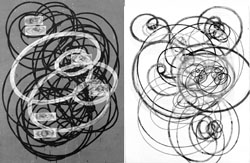

FAVA Show Has Promise, but Comes Up
Short
BY NICK STILLMAN
Although the new exhibition at the Firelands Association for the Visual
Arts gallery may not be the best show it has displayed this semester,
it is the most coherent in terms of presentation and certainly the most
spiritually searching. Circles, Cycles and Structures shows pieces from
four Northeast Ohio artists, each focusing on the personal and expressive
as a theme.
Martin Ball’s paintings are the first works the viewer encounters when
entering the two-room gallery. While Ball’s media are traditional —
paint on canvas and panel — he manages to create a convincing sense
of movement and illusion on two-dimensional planes.

|
Each of his works are untitled, differentiated
only by numbers the FAVA curator has placed adjacent to the paintings.
The choice to leave the works untitled makes sense, since Ball seems
to have created a personal style and these works are presumably members
of a larger series. Three of the paintings are compositionally similar
— multicolored circles and ellipses dancing over a white background.
In each of these works, Ball has structured the composition so as to
create a sense of movement. However, while Op artists from the 1960s
like Bridget Riley tended to favor stark black and white colors for
this static kinetic art, Ball uses loud gaudy colors, distracting the
eye from the structure and composition of his works.
The best of Ball’s paintings is also the most inconspicuously displayed,
hidden near the reception desk. The artist uses a reduced range of colors
— mostly midnight blue with touches of gold and green — to create a
dizzying sense of swirling motion that is best seen when standing at
a distance. A close inspection reveals the human touch in the work,
as several of the lines that appear exact from a distance are broken
and imperfect.
In terms of process, Laurie Addis’ work is the most interesting of all
the displayed artists. Several of Addis’ mosaic-like cloths are on display.
To create her compositions, Addis designs the elements of color and
pattern on a computer, then uses a computer-assisted loom to weave them,
intentionally utilizing a flaw in the dye process that lends a streaky
effect to the works.
Addis is best described as a colorist — her most successful works make
use of several varieties of the same hue for nearly the entire piece.
In “Blur” she uses purple and gold coloration, woven with spaces in
between the elements of the color field to give the piece a fuzzy abstracted
feeling.
Three large weavings by Addis are included in Circles, Cycles and Structures,
two of which are well over 10 feet tall. All appear to have been woven
more crisply than the smaller works on display and fail to convey the
blurry warmth that make her smaller pieces work well.
Hildur Jonsson has three weavings on display, each including environmental
imagery. The most breathtaking of her three works is also the largest.
“Mountains” is a large, meticulously-executed weaving, approximately
6’x6’. The piece can be separated into a top and bottom half. The top
is a shimmering yellow with a simplistic mountain included just above
the dividing line, while the bottom is a vague bluish-green hue with
a reflection of the same mountain.
“Mountains” appears to be a work indebted to Rothko’s massive fuzzy
abstract paintings. Although the weaving is composed of two basic hues,
several areas are discolored, giving the piece a fuzzy, dreamy feeling
similar to Rothko’s best paintings. A few areas of the piece don’t work
— the divide between the two colors is too crisp and calls for a fuzzy
integration to cohere with the work as a whole. Also, the muddy aqua
color works poorly with the glistening yellow. Still, of all the displayed
artists, Jonsson’s work has the most potential, especially if she increases
the size to a massive scale.
Of all the works on display, the flamboyantly-colored abstract paintings
by Craig Lucas register the least. Lucas’ work is based in movement
— his paintings look like gumballs moving rapidly down the chute of
a machine. The streaky paint application conveys motion successfully
and the bright primary colors Lucas works with lend a carefree childishness
to his works, but the unplanned look of his paintings feels too premeditated
to work successfully.
Circles, Cycles and Structures is a spiritual and earthy show — a refreshing
change from austere postmodernism. Although none of the artists can
claim that every displayed piece of theirs succeeds, the exhibition
offers hope for a vibrant and unique artistic culture in Northeast Ohio.
![]()
Students Bring Quartett's Sinister Eroticism to Life
New Student Poetry Group Opens for Alix Olson
FAVA Show Has Promise, but Comes Up Short